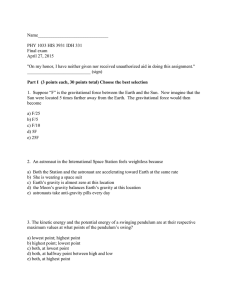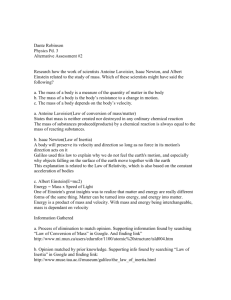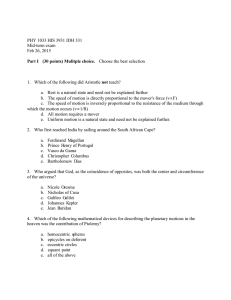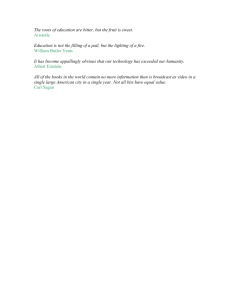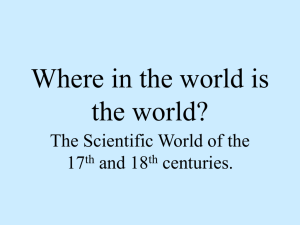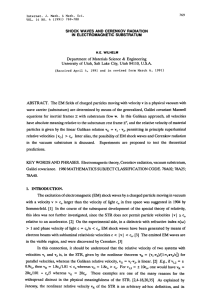Name_______________________________ PHY 1033 HIS 3931 IDH 331 Final exam
advertisement
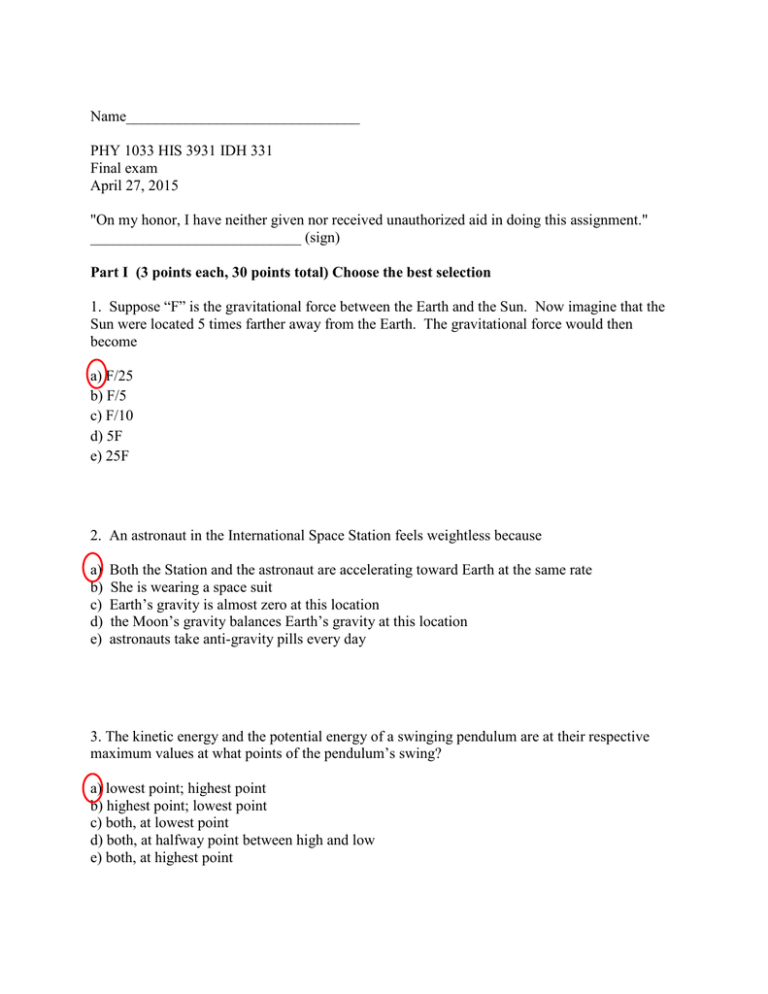
Name_______________________________ PHY 1033 HIS 3931 IDH 331 Final exam April 27, 2015 "On my honor, I have neither given nor received unauthorized aid in doing this assignment." ____________________________ (sign) Part I (3 points each, 30 points total) Choose the best selection 1. Suppose “F” is the gravitational force between the Earth and the Sun. Now imagine that the Sun were located 5 times farther away from the Earth. The gravitational force would then become a) F/25 b) F/5 c) F/10 d) 5F e) 25F 2. An astronaut in the International Space Station feels weightless because a) b) c) d) e) Both the Station and the astronaut are accelerating toward Earth at the same rate She is wearing a space suit Earth’s gravity is almost zero at this location the Moon’s gravity balances Earth’s gravity at this location astronauts take anti-gravity pills every day 3. The kinetic energy and the potential energy of a swinging pendulum are at their respective maximum values at what points of the pendulum’s swing? a) lowest point; highest point b) highest point; lowest point c) both, at lowest point d) both, at halfway point between high and low e) both, at highest point 4. Suppose you look at the huge clock on the Big Ben Tower in London and it reads 12 noon. If you could travel directly away from the clock at the speed of light and view it with a telescope, it would (a) run faster than usual. (b) be frozen at 12 noon. (c) run slower than usual. (d) be contracted. (e) be elongated. 5. Who first noticed that changing a magnetic field produced electricity? a) b) c) d) e) Faraday Maxwell Franklin Ptolemy Galileo 6. What measurement is Eratosthenes most famous for? a) b) c) d) e) Distance to sun Weight of the Earth Circumference of the Earth Electric charge on a proton Distance from Marathon to Athens 7. Who said, “If I have seen farther than others, it is because I have stood on the shoulders of giants.” a) b) c) d) e) Newton Galileo Einstein Napoleon Goethe 8. Which of the following are some of Kepler’s laws of planetary motion? a) b) c) d) e) Planets move in ellipses with the sun at one focus T2 ∝R3 a=mv2/R b and c a and b 9. Who argued that in order to run a heat engine you need reservoirs at two different temperatures? a) Boltzman b) Watt c) Leibniz d) Lord Kelvin e) Carnot 10. Bohr’s model was criticized by classical physicists, who believed a) b) c) d) e) protons and electrons both had positive charge atoms did not exist the proton should orbit the electron, not vice versa electrons did not exist the atom would collapse because the accelerating electrons would radiate energy Part II (2 pts each, total 40 points) Answer the following briefly: 1. Supposing you were standing on a train car moving with speed v relative to the ground as shown, and you shine a flashlight in the direction of travel. You observe, and announce that the beam travels with speed c relative to you (the train car). An observer on the ground who believes in Galilean relativity and the ether watches you travel by. What does he expect the speed of the light beam to be? Now suppose the observer is Einstein. What does he expect the speed of the light beam to be? Explain. The Galilean observer on the ground expects to see that the light velocity will add to the cart velocity, so he will see the beam propagating with velocity v+c. The Einsteinian observer expects to see velocity c, since the speed of light is the same in all reference frames. When the experiment is done, Einstein is right! 2. Name two contexts in which Newton’s inverse square law was challenged and/or vindicated in the eighteenth century. Possible answers: a) delayed return of Halley’s comment (Clairaut prediction); b) measurements of the shape of the Earth; c) disproval of Clairaut’s proposal that a 1/r4 term was necessary to account for the influence of the sun on the motion of the moon; d) apparent shrinking of moon’s orbit (shown by Laplace to be slow oscillatory change in moon’s period due to influence of other planets) 3. In Einstein’s thought experiment about holding a mirror in front of him while moving at the speed of light, either he would see his reflection or he would not. Not seeing his reflection violated a fundamental assumption of physics. What was that assumption and how would it be violated? That the speed of light is the same in all reference frames. Or, you could say that not seeing reflection violates Galilean relativity. 4. The Age of Realism showed itself in numerous contexts in the second half of the nineteenth century other than in physics. Name two such contexts and give an example of each. Bismarck’s Realpolitik, realism in literature (Flaubert, Stendahl), in art (Courbet, photography), in religion (Feuerbach), in philosophy (scientific materialism, e.g. Buchner). Emergence of new technologies. Marx (das Kapital), Darwin (Origin of Species) 5. What was it that Osiander said in the Foreword to Copernicus’s book to try to make it more acceptable? That the motion of the earth was just a hypothesis, a calculational tool, but that Copernicus did not say that the earth “really” moved. 6. The Greeks argued that all heavenly bodies must move in perfect circles at uniform velocity. What two individuals were the first to violate/challenge a. the notion that heavenly motion must involve geometrically perfect circles only b. the uniformity (constant speed) of circular motion a. Kepler b. Ptolemy 7. There were several developments in the early twentieth century that, in utilizing Planck’s notion of quantizing energy, confirmed its importance for physics. Name and explain briefly one of these developments. Photoelectric effect Bohr atom 8. Explain how Eddington verified Einstein’s theory that light bent in a gravitational field. Use a sketch if helpful. Eddington was looking for the bending of light from a distant star as the light passed the sun on its way to the Earth. He needed the eclipse to allow the star to be visible. 9. State at least one property of the ether, the medium that 19th century physicists thought allowed light waves to propagate. Could say that the ether was “stiff”, because the speed of light was so fast; or that it was practically unresistant, because planets, etc move through it. 10. Many 19th century physicists believed generally in “determinism”. What, according to Laplace, could a sufficiently great intellect do if given the positions and velocities of all the particles in the universe at one time? Given the positions and velocities of all the particles in the universe, he/she could predict the exact motion of every particle at any time in the future or in the past. 11. Is electricity or gravity more important for atomic physics and chemistry? Why? Electricity, because gravity is extremely weak 12. How did Galileo use a thought experiment to disprove Aristotle’s contention that falling bodies that are twice as heavy fall twice as fast? (Hint: he considered two objects tied together) Aristotle would say that two individual bodies, one with mass m and one with mass 2m, would fall individually with different speeds v and 2v. However Galileo pointed out that if they were tied together, this would mean that the light object would retard the heavy one, and make it fall more slowly. On the other hand, if you regarded the combined object as mass 3m, it should fall faster – hence a contradiction! 13. Explain why we have seasons, using a diagram. What days mark the beginning of each season in the northern hemisphere? Show where the Earth is on your diagram at the beginning of each season. 14. Galileo used objects sliding and rolling on inclined planes for his experiments on motion to refute Aristotle. What was the main purpose of this apparatus? To slow down the acceleration of falling bodies so that they could be observed more accurately. 15. Heisenberg derived an “uncertainty principle”. Explain briefly what it means. ∆x∆p~h. You can’t measure the position and the momentum of an object simultaneously with arbitrary precision. Here ∆x is the uncertainty in position and ∆p the uncertainty in momentum. Another way to say it is that if you know exactly where something is, you can say nothing about its momentum, or velocity. 16. Draw a diagram of the Michelson Morley experiment, and explain what they were attempting to measure. The interferometer was designed to detect the delay in the arrival of a light pulse due to the “ether wind” along the direction of the Earth’s motion through the ether. 17. A helium atom weighs a little bit less than four hydrogen atoms. Explain how this relates to the Sun’s energy. The missing mass is released in the form of energy (E=mc2) in nuclear fusion. This process powers the stars. 18. Name 2 of the 4 motions of the earth identified by Copernicus. a) b) c) d) Revolution Rotation Precession of equinoxes Weird twisting of Earth’s axis in order to make it point always towards the pole star. 19. Explain why, according to current understanding, the lengths of the seasons (time between equinox and solstice) are not quite equal. Because the Earth’s orbit is elliptical, not circular, and the Earth moves faster when it is closer to the sun (northern hemisphere winter). 20. Cecelia Payne’s thesis called “the most brilliant Ph.D. thesis ever written in astrophysics” What was her great discovery? That the composition of the sun and other stars was mostly hydrogen and helium Part III. (30 pts) Essay. Choose one of A, B or C (Do not do more than one). A. Thomas Kuhn describes the structure of a scientific revolution by the following pattern: normal science, novelty, anomaly, crisis, paradigm shift. Utilizing Kuhn’s structure, choose one of the following and construct an argument that it does or does not constitute a scientific revolution Special Relativity Quantizing energy B. From the following list of major figures in the development of our understanding of electromagnetic radiation, identify the contributions of any four of them and explain how each arrived at his results. Thomas Young Hans Christian Oersted Michael Faraday James Clerk Maxwell Heinrich Hertz Albert Einstein C. By describing the cosmos at the time of Aristotle and Ptolemy, the universe at the time of Newton, and modern conceptions since the time of Einstein, explain how Western humankind changed its view of “The Universe and Humanity’s Place in It.”
